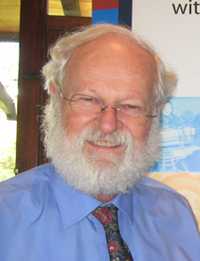
Contents
View Professor Nick Hoogenraad's photo gallery
You can order the DVD from the Academy for $15 (including GST and postage)
Professor Nick Hoogenraad was interviewed in 2010 for the Interviews with Australian scientists series. By viewing the interviews in this series, or reading the transcripts and extracts, your students can begin to appreciate Australia's contribution to the growth of scientific knowledge and view science as a human endeavour. These interviews specifically tie into the Australian Curriculum sub-strand ‘Nature and development of science’.
The following summary of Hoogenraad’s career sets the context for the extract chosen for these teachers’ notes. The extract discusses the import of proteins into the mitochondria and Hoogenraad’s discovery of the mammalian signal peptide. Use the focus questions that accompany the extract to promote discussion among your students.
Nicolaas Johannes (Nick) Hoogenraad was born in The Hague, Holland in 1942. He then spent part of his childhood in Indonesia before immigrating to Australia in 1952. At fifteen, Hoogenraad went to sea but soon returned to finish his secondary schooling at McLeod High School. Hoogenraad graduated from the University of Melbourne with a BAgSc (1965) and a PhD in Biochemistry (1969). Hoogenraad’s PhD thesis was on the role of bacteria to the nutrition of sheep. During his PhD, Hoogenraad was also a senior demonstrator for agricultural and medical practical classes.
Hoogenraad commenced a postdoctoral fellowship in the Department of Paediatrics at Stanford University in 1970 and was appointed to assistant professor in Human Biology in 1972. Whilst in the US, he worked on purifying an enzyme of the pyrimidine biosynthetic pathway, work which sparked an interest in compartmentalisation. Hoogenraad returned to Australia and the newly established Department of Biochemistry at La Trobe University in 1974. It was at La Trobe University that he conducted research into mitochondrial protein import and the mitochondrial stress response. Hoogenraad was given a personal chair in Biochemistry (1992), made head of the Department of Biochemistry (1993) and head of the School of Molecular Sciences (1998) – a position he still holds. As well as his research and administrative responsibilities, Hoogenraad continues to take an active interest in science education at both a secondary and tertiary level.
Professor Hoogenraad’s scientific work has been recognised through the awarding of the Australian Society for Biochemistry and Molecular Biology’s Amersham-Pharmacia medal (1994) and Lemberg medal (2004), Leach lecturer at the Lorne Protein and Function Conference (1997), lecturer and medallist in the Barbara Ell Seminar Series of the Victor Chang Cardiac Research Institute (2005) and the Dean’s medal from La Trobe University for Outstanding Service to Science and Engineering (2010). In 2011 La Trobe University awarded him a Charles La Trobe Professorship in recognition of his long and distinguished contribution to science at the university.
Protein import to the mitochondria
My lab immediately became interested in the role of chaperones in protein import. Proteins destined for the mitochondria have an address signal on them and the matrix proteins have an extension on their N- terminal end. In the ornithine transcarbamylase case, it was 32 amino acids long. We became interested in that because, when we cloned ornithine transcarbamylase, we discovered that there were 32 amino acids in the sequence that I hadn’t found when I had done the N-terminal sequence of the mature purified protein. So we became interested in what those 32 amino acids were doing.
There were 32 amino acids that had been removed somehow.
It was pretty easy to make the prediction that they were there to specify where the postman should deliver the letter, the address if you like. A series of PhD students in my lab looked at that particular question. We did it in mammalian species. Schatz and Neupert were the main competitors, Schatz in yeast and Neupert in Neurospora. I guess our progress was fairly slow because we were using mammalian species and we didn’t have the power of genetics on our side.
But I finished up joining forces with a Japanese person called Masa Mori, who became a close friend. I found that he was almost my mirror image in another country with a love of classical music and a love of woodwork, and he was choosing exactly the same questions to answer as I was. It became disconcerting and I wrote to him and said, ‘I think we should talk.’ We did talk, and we met and collaborated from that point on, which was lovely. That is one of the wonderful things about science.
So these proteins are either delivered to the mitochondria or they find their way there. There is machinery in the mitochondria that proofreads the signal and says, ‘Yes, you can come in.’ Then the precursor protein gets pulled in by a machinery inside the matrix of the mitochondria. The machinery is now well understood. It is just like machinery – like tugging on a piece of string and pulling it in. Then, when these proteins get inside, the signal peptide is cleaved off so that it can never leave again. It is now trapped inside. It was later found that proteins that are destined for the outer and the inner membrane, proteins of the electron transport chain and so forth, have a different sort of signal. They have an internal signal which is not cleaved off when they get in. They become embedded in the membrane and it keeps them there.
Focus questions
Select activities that are most appropriate for your lesson plan or add your own. These activities align with the Australian Curriculum strand ‘Science Inquiry Skills’ and the New South Wales syllabus Stage 4 Science outcomes 4.8.1, Stage 6 Biology outcomes 8.3.1 and 8.3.2 and Stage 6 Chemistry outcomes 9.7.4 and 9.9.3. You can also encourage students to identify key issues in the preceding extract and devise their own questions or topics for discussion.
amino acids
cell
chaperone
membrane
mitochondria
matrix
N-terminal
protein
sequence
signal peptide
© 2025 Australian Academy of Science